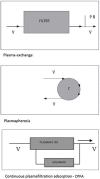Posthepatectomy liver failure
- PMID: 32718126
- PMCID: PMC7605090
- DOI: 10.3906/sag-2006-31
Posthepatectomy liver failure
Abstract
Liver surgery is one of the most complex surgical interventions with high risk and potential for complications. Posthepatectomy liver failure (PHLF) is a serious complication of liver surgery that occurs in about 10% of patients undergoing major liver surgery. It is the main source of morbidity and mortality. Appropriate surgical techniques and intensive care management are important in preventing PHLF. Early start of the liver support systems is very important for the PHLF patient to recover, survive, or be ready for a liver transplant. Nonbiological and biological liver support systems should be used in PHLF to prepare for treatment or organ transplantation. The definition of the state, underlying pathophysiology and treatment strategies will be reviewed here.
Keywords: Liver surgery; Posthepatectomy Liver Failure; Prevention; Treatment.
This work is licensed under a Creative Commons Attribution 4.0 International License.
Conflict of interest statement
The authors declare that they have no conflict of interest. This review was prepared without any support from funding agencies in the public, commercial, or nonprofit sectors.
Figures



References
-
- Rahbari NN Garden OJ Padbury R Maddern G Koch M. Posthepatectomy liver failure: a definition and grading by the International Study Group of Liver Surgery (ISGLS) Surgery . 2011;149:713–724. - PubMed
-
- Paugam-Burtz C Janny S Delefosse D Dahmani S Dondero F. Prospective validation of the ‘fifty-fifty’ criteria as an early and accurate predictor of death after liver resection in intensive care unit patients. Annals of Surgery . 2009;249:124–128. - PubMed
-
- Hammond JS Guha IN Beckingam IJ Lobo DN. Prediction, prevention, and management of postresection liver failure. British Journal of Surgery . 2011;98:1188–1200. - PubMed
-
- Mullen JT Ribero D Reddy SK Donadon M Zorzi D. Hepatic insufficiency and mortality in 1059 noncirrhotic patients undergoing major hepatectomy. Journal of the American College of Surgeons . 2007;204:854–862. - PubMed
Publication types
MeSH terms
LinkOut - more resources
Full Text Sources
Medical

